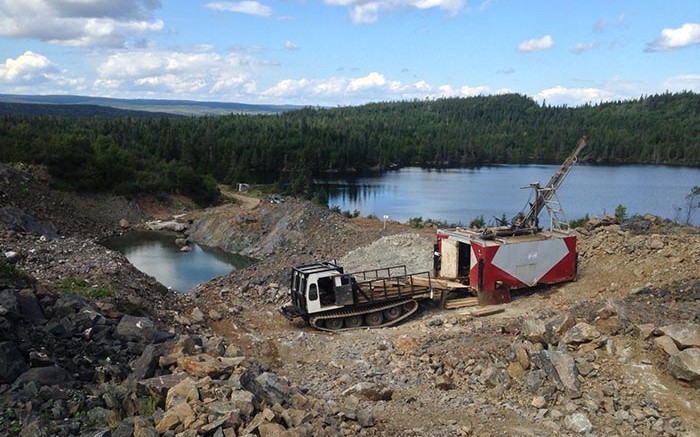VANCOUVER — With renewed exploration, Anaconda Mining (TSX: ANX; US-OTC: ANXGF) is laying the groundwork to revitalize its open-pit Pine Cove gold mine, 6 km northeast of the town of Baie Verte in north-central Newfoundland, even as declining gold prices put pressure on the junior miner.
The company reported 12.8 grams gold per tonne over 4.4 metres and 8.6 grams gold over 5 metres from channel samples taken across the Stog’er Tight prospect, 3.5 km east of the mine site.
The program will take a 2,800-tonne bulk sample at the prospect later this year, once the company establishes the deposit’s National Instrument 43-101 compliant resource. Dustin Angelo, president and CEO of Anaconda, tells The Northern Miner that the company believes Stog’er Tight could add years to the mine life.
“Pine Cove has three years left on the books, so we’re at that point where we need to continue to invest in the project and show that there’s a much longer life here,” he says. “It’s been a really positive experience, and we believe Stog’er Tight is on its way to becoming the next deposit mined.”
Anaconda looks to expand on a non-compliant historical reserve at Stog’er Tight of 65,200 tonnes grading 5 grams per tonne gold, and indicated resources of 96,000 tonnes grading 7 grams gold. The company plans to spend another $500,000 in the next fiscal year on drilling programs that target its extensions.
Angelo says the drills will also be turning at its Pine Cove deposit, with $500,000 budgeted for drilling the northwest and southeast extensions of vein-hosted mineralization. The company says the drill-out could add 45,000 oz. gold to the open-pit resource and add three years to its mine life.
Mill throughput at the Pine Cove mine is 1,050 tonnes per day with an 83–85% recovery rate at an average grade of 1.8 grams gold.
Angelo notes the company intends to double production from 15,000 to 30,000 oz. gold per year by adding feed to the mill from high-grade satellite prospects such as Romeo and Juliet, just 1.5 km north.
“The prospects will require additional drilling, but so far, the results have been encouraging,” he says, referring to a 1,000-tonne bulk sample at the Juliet zone in 2013 that returned a weighted average grade of 5.7 grams gold.
“Extending mine life has always been part of our long-term plan, but doubling production is more in response to the declining gold price, and to get our cash costs per ounce down.”
According to the company’s financial report for the nine months ending Feb. 28, 2015, the debt-free junior generated $16.6 million in gross revenue from selling 11,872 oz. gold.
But all-in-sustaining-costs (AISC) for producing an oz. gold are still a challenge, as exploration and development costs ramp up.
For nine months, AISC were a reported C$1,466 per oz. gold — or 5% higher than the sale price of C$1,390 per oz. gold for the same period.
“We don’t have a big balance sheet to weather the storm like the bigger companies do, but we’re still in good shape,” he says, noting the company has a positive cash flow from operations of $2.3 million for the same period. “The focus now is to drive the operating costs down, so that we can spend more on exploration.”
Anaconda said in a presentation that it would lower its cash-operation costs to $960 per oz. gold this year by reducing haul distances, automating the mill and improving grades. Cash costs for the eight months ending Feb. 28 were $1,095 per oz. gold.
On a corporate side, Angelo says the company would like to take advantage of the downswing and shop around for projects being sold at a discount.
“We’re the only pure-play gold producer in all of Atlantic Canada, so that puts us in a competitive advantage when we’re looking at acquiring other properties,” he says. “Our goal is to get to the point where we’re producing 100,000 oz. gold a year over multiple projects.”
In early August, the company entered an option with Seaside Realty to acquire 100% of the Corkscrew mining lease contiguous to Anaconda’s Pine Cove, Stog’er Tight and satellite deposits. The lease, which includes five gold occurrences, doubles the company’s land position and effectively gives the company full control of the highly prospective Goldenville trend.
“That was really big for us because it was the last piece of the puzzle, and we got it at a great price,” he says.
Pursuant to the deal, Anaconda needs to pay Seaside $75,000 over two years with $25,000 paid at closing, in addition to a 2% net smelter royalty capped at $2 million.
Anaconda has traded within a 52-week range of 4¢ to 8¢ per share, and closed at 4¢ at press time. The company has 179.9 million shares outstanding for a $7.2-million market capitalization.


Be the first to comment on "Anaconda invests in Pine Cove’s future"